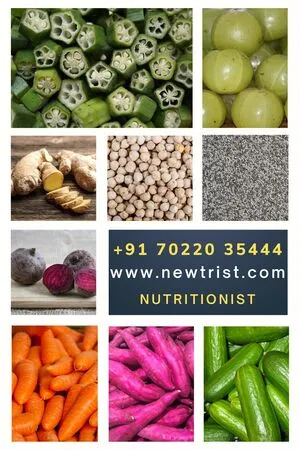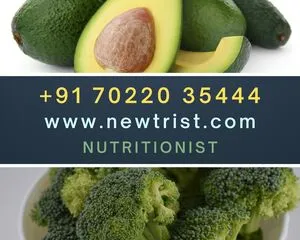The Endometriosis diet plan includes fresh fruits, vegetables, whole grains, healthy fats like omega-3 fatty acids, and foods rich in iron and antioxidants. Anti-inflammatory foods like fatty fish, nuts, seeds, and leafy greens reduce inflammation and pain.
- Early morning drink @ 6:30 am: Red alert juice
- Breakfast @ 9 am: Scrambled eggs with baked sweet potatoes and amla juice
- Mid-morning meal @ 11 am: Mixed vegetable soup
- Lunch @ 1 pm: Rice with black channa curry and stir-fried beetroot
- Evening snack @ 4 pm: Shredded chicken salad with broccoli and greens
- Dinner @ 7 pm: Neer dosa with egg curry and a cup of low-fat curd
Best Nutritionist in Bangalore
Consult 19-year-experienced Chief Nutritionist Vasanthi, in person at HSR, Koramangala, Bellandur, Haralur, Electronic city, or online across India.

Table of Contents
What is Endometriosis?
Endometriosis is a painful autoimmune condition that is characterized by the growth of cells and tissues outside the uterus. The tissues resemble the cells that are present in the inner lining of the uterus. The patient may be subjected to a slight risk of ovarian cancer although it is rare for the tissue growth to spread to the fallopian tubes, ovaries, and pelvic region.
Almost 1 in 10 women are affected by this painful condition which if untreated can lead to ovarian cancer. The disease cannot be cured completely but following a healthy diet and regular workout routine can have a positive effect on the pain and progression of the condition.
Dietary modifications help in the effective management of endometriosis. Healthy foods like fruits, vegetables, and whole grains reduce the levels of estrogen levels and oxidative stress which aggravates pain and inflammation.
Mild symptoms may not require treatment unless there are no problems in fertility. Endometriosis may gradually get better on its own for some people but it is important to keep an eye on the magnitude of the symptoms.
Physical exercises play a major role in regulating estrogen levels and the release of happy hormones that lower pain and discomfort. Avoid heavy intense workouts and perform some simple exercises like walking, swimming, yoga, and aerobics.

What are the symptoms of Endometriosis?
The symptoms of Endometriosis are
- Intensive pain during periods
- Heavy bleeding during and in-between periods
- Pain during bowel movements and urination
- Back pain
- Cramps
- Constipation
- Diarrhea
- Bloating
- Fatigue
- Infertility
The symptoms of endometriosis may not indicate the severity of the condition. Sometimes mild endometriosis may be characterized by severe pain or vice-versa. Endometriosis may be sometimes misunderstood as ovarian cysts or Pelvic Inflammatory Disease (PID) as they share common symptoms.
IBS is another condition that can be misinterpreted as endometriosis. IBS can accompany endometriosis and make diagnosis more complicated.
Endometriosis can be diagnosed with pelvic examination, ultrasound scan, MRIs, and laparoscopy. The treatment involves the use of medications and in severe cases, surgery is carried out. Some pain medications and hormone therapies are often used to relieve the pain and symptoms of endometriosis. Conservative surgery involves the surgical removal of endometriosis implants preserving the uterus and ovaries.
A warm shower and hot water packs can help reduce the pain and cramps in pelvic muscles. The exact cause of endometriosis is unknown. Genetic factors may have some impact on the prevalence of the disease.
What are the 4 stages of Endometriosis?
The 4 stages of endometriosis are Minimal (stage 1), Mild (stage 2), Moderate (stage 3), and Severe (stage 4).
What is the 1st stage of endometriosis?
During this stage, small wounds and shallow endometrial implants are seen on the ovaries. Stage 1 contains very few implants and small wounds. Inflammation of the pelvic cavity is also one of the earliest symptoms of endometriosis.
What is the 2nd stage of endometriosis?
In mild (stage 2) endometriosis, the implants count larger in number compared to stage 1 and it is deeper in the tissue. Scar tissues may also be seen in stage 2 endometriosis.
What is the 3rd stage of endometriosis?
In stage 3 endometriosis, deeper implants and the presence of small cysts on the surface of the ovaries are noticed. Thick bands of scar tissues called adhesions are also seen during this stage.
What is the 4th stage of endometriosis?
Deeper implants and dense endometrial adhesions on various organs are seen in stage 4 endometriosis. Women in stage 4 endometriosis need immediate surgery and may experience signs of infertility.
What are the 4 types of Endometriosis?
The 4 main types of Endometriosis are Superficial peritoneal endometriosis, Endometriomas, Deeply infiltrating endometriosis (DIE), and Abdominal wall endometriosis.
What is Superficial Peritoneal Endometriosis?
In superficial peritoneal endometriosis, the endometrial tissues attach to the peritoneal membrane. Peritoneum is a thin membrane that is present in the abdominal and pelvic lining. This type of endometriosis is the least severe form of endometriosis.
What is Endometriomas?
Endometriomas are also called chocolate cysts which are filled with dark, fluid cysts. They differ in size and can be found in various parts of the pelvis and are most commonly found in the ovaries.
What is Deeply Infiltrating Endometriosis (DIE)?
In DIE, the endometrial tissue has reached the organs surrounding the pelvic cavity which includes the bowels, rectum, ovaries, and bladder. Deeply Infiltrating Endometriosis is also called Frozen Pelvis which is a rare form.
What is Abdominal Wall Endometriosis?
In this condition, the abnormal growth of endometrial tissues is found on the walls of the abdomen. The tissues may attach to the surgical incision.
Endometriosis Diet Plan
Endometriosis Diet Plan consists of foods high fiber foods like fruits, vegetables, whole grains, beans, legumes, and nuts. Include a lot of colored fruits and vegetables that provide a good source of antioxidants and phytochemicals. A diet lacking in antioxidants may contribute to the symptoms of endometriosis.
- Early morning drink @ 6:30 am: Ginger tea
- Breakfast @ 9 am: Sandwich toast with sliced avocados and cucumber
- Mid-morning meal @ 11 am: Chia seeds pudding with coconut milk
- Lunch @ 1 pm: Brown rice with spinach dal, ladies’ finger sabzi, and low-fat curd
- Evening snack @ 4 pm: Sprouts chat with onions and raw mangoes
- Dinner @ 7 pm: Oats upma with vegetables

Foods to avoid with Endometriosis
Foods to avoid with Endometriosis are
- Foods high in saturated fats and trans fats
- Red meats
- Gluten-rich foods
- Refined foods
- Caffeinated beverages
- Salty foods
- High FODMAP foods.
The addition of these foods promotes inflammation and leads to the progression of the disorder.
What are the effects of saturated fats and trans fats on endometriosis?
Fried foods and fast foods are high in saturated fats and trans fats that contribute to the symptoms of endometriosis. A diet high in unhealthy foods increases the risk of endometriosis by 48%. Continuous intake of highly fatty foods also increases the risk of other lifestyle disorders.
How does red meat affect endometriosis?
Daily consumption of more than two servings of red meat has been found to increase the risk of endometriosis by 56%. The presence of heme iron promotes inflammation and oxidative stress during endometriosis. Since endometriosis patients are mostly iron-deficient, the presence of iron-rich foods plays a major role in the treatment of anemia. Consult with our health nutritionists to know your level of red meat intake.
Is a gluten-rich diet good for endometriosis?
A restriction of the gluten-rich diet showed improvement in the symptoms of endometriosis when followed over 12 months. Reduced side effects and pain were observed with a gluten-free diet. No negative effects are reported with a gluten-free diet on endometriosis.
How do refined and processed foods affect endometriosis?
Refined and processed foods are rich in omega-6 fatty acids and arachidonic acid that cause the metabolization of prostaglandins and increase pain and inflammation. Processed foods further increase the risk of diabetes, obesity, and lifestyle disorders. Limit the intake of cakes, pastries, muffins, cookies, noodles, white bread, pasta, chips, and fried foods.
Is caffeine good for endometriosis?
Caffeinated drinks stimulate inflammation, increase estrogen levels, and worsen the symptoms of endometriosis. Our expert nutritionists advise cutting back on coffee and other stimulants to maintain hormonal balance and improvement of the symptoms of endometriosis.
What is the role of high FODMAP foods on endometriosis?
Women with endometriosis are more prone to IBS even with a healthy bowel. A low-FODMAP food help in the effective management of IBS and symptoms of endometriosis. High-FODMAP foods are also high in gluten, so it is best advised to stay away from high-FODMAP foods like wheat-based foods, onions, garlic, apples, pears, and full-fat dairy.
Best vegetables for Endometriosis
The best vegetables for Endometriosis are
- Dark leafy greens
- Green beans
- Broccoli
- Beetroot
- Tomatoes
- Carrots
- Bell peppers
- Sweet potatoes
- Peas
- Cauliflower
- Brussel sprouts
- Mushrooms
- Ladies finger
- Eggplant
- Colocasia
- Bitter gourd
Vegetables are a healthy part of a healthy balanced diet. Vegetables possess anti-inflammatory and antioxidant properties with a wide range of vitamins, minerals, and fiber. Try to consume 4-5 servings of vegetables per day.
A healthy fiber-rich diet helps to ease constipation and regulate bowel movements which helps in removing excess estrogen from the body. Increased levels of estrogen may cause cramping and pain that aggravates the other symptoms of endometriosis.
Try adding nuts and seeds like almonds, walnuts, chia seeds, flax seeds, and pumpkin seeds provide a rich source of omega-3 fatty acids that help in alleviating inflammation and relieving muscle and joint pain. Omega-3 fatty acids also help in regulating hormonal fluctuations.
Best fruits for Endometriosis
The best fruits for Endometriosis are
- Bananas
- Grapes
- Oranges
- Lemons
- Pomegranates
- Pineapples
- Kiwis
- Avocados
- Strawberries
- Honeydew melons
Fruits are loaded with antioxidants, vitamins, and minerals which account for reducing inflammation. The nutrients from the fruits are essential to carry out the chemical reactions of the cells, supply energy, and vital functions of the tissues.
Fruits also regulate bowel movements and ensure the elimination of waste and toxic substances from the body. Regular intake of fruits helps in improving the immune system’s defense and protects against the damage caused due to the action of free radicals.
Fruits are rich sources of minerals like calcium, iron, zinc, manganese, cobalt, and potassium that aid in the elimination of the byproducts of nitrogen metabolism and excess chlorides.
The citric acid and ascorbic acid present in the fruits stimulate the production of digestive enzymes that promotes digestion and absorption of nutrients in the intestines and prevents constipation.
Tips for Endometriosis
Wise choices of healthy foods like fruits, vegetables, whole grains, nuts seeds, foods rich in omega-3 fatty acids, and antioxidants help to lower inflammation and provide protection against endometriosis. A nutritious diet reduces the metabolism of prostaglandins and estrogen activity.
Steering clear of high-fat foods like red meat, processed foods, refined foods, baked goods, high FODMAP foods, and fried foods aggravate the levels of estrogen and cause excessive growth of endometrial tissues.
Regular exercise may reduce the pain and discomfort gradually that improve blood circulation to the organs. Physical activity reduces estrogen production, and stress, and promotes the release of endorphins in the brain which relieves pain.
Stress management may aid in the improvement of symptoms. Stress can result due to pain, work environment, and relationships. Stress can exacerbate endometriosis symptoms and vice-versa. Relieve your stress with deep breathing techniques and yoga.
Alternative therapies with the help of a trained physician can help with endometriosis. Osteopathic Manipulative treatment (OMT) involves stretching, gentle pressure, and resistance in the movement of joints and muscles.
Acupuncture promotes anti-inflammatory effects and stimulates the release of pain-relieving brain chemicals. Acupuncture is a useful remedy for relieving endometriosis pain and is effective among young women.
Foods to prevent Endometriosis
Foods to prevent Endometriosis are fresh fruits, vegetables, whole grains, nuts, seeds, lean meats, fatty fish, and foods rich in omega-3 fatty acids. A diet rich in omega-3 fatty acids reduced the risk of endometriosis by 22%. When a woman stays on a healthy diet, she is far from the risk of endometriosis. Healthy fats derived from avocados, olive oil, nuts, seeds, and fatty fish provide anti-inflammatory effects. According to a 2015 study, a healthy diet prevents the development of endometriosis and also from worsening the symptoms.
Office on Women’s Health portrays endometriosis as unpreventable. Lifestyle and dietary modifications may not cure endometriosis but it helps in the improvement of the symptoms. A diary of regular food intake is essential to identify the effects of food with endometriosis.
A reduced caffeine intake can regulate estrogen levels as increased levels may lead to inflammation and other symptoms. Increased fiber intake can lower estrogen levels in addition to the surplus supply of vitamins, minerals, and antioxidants to the body. A gluten-free diet reported improvement in the symptoms of endometriosis by following it over 12 months.
A low FODMAP diet’s goal is the healing of the gastrointestinal tract with a diet devoid of simple carbohydrates that may irritate the intestine. Some people find it difficult to follow this kind of menu plan that eliminates dairy, gluten, refined sugars, and processed foods.
A nutritionist can help with the elimination and reintroduction of foods to observe the body’s response to a particular food.
FAQ
Is Endometriosis curable?
Endometriosis cannot be completely cured but treatment can help to ease the symptoms. A healthy diet and dietary modifications relieve pain and improve inflammation and other symptoms. Endometriosis is a life-long chronic inflammatory condition that affects a woman’s physical, and emotional well-being and daily routine.
What are the best foods to eat for Endometriosis?
The best foods to eat for endometriosis are fresh fruits, vegetables, whole grains, nuts, seeds, lean meats, iron-rich foods, fatty fish, and foods rich in omega-3 fatty acids and antioxidants. Exercise can also lend a helping hand in the management of endometriosis. Exercise reduces estrogen levels and increases the production of “feel-good” hormones.
What is the natural remedy for Endometriosis?
The natural remedy for Endometriosis is
Heat therapies – if a woman is facing flare-ups of symptoms, gentle heat therapy may alleviate cramps and pain during periods. A warm shower can make you feel better.
Bromelain (found in pineapples) in association with N-acetyl cysteine and alpha lipoic acid reduces pelvic pain in patients with endometriosis.
Include ginger and turmeric in the diet as it possesses anti-inflammatory properties that benefit endometriosis symptoms. Curcumin in turmeric reduces endometriosis pain. Ginger helps in treating nausea and bloating issues.
How can I reduce Endometriosis?
A healthy diet and exercise may help to reduce endometriosis. Heat therapies, anti-inflammatory foods, massage, and yoga can lower the severity of the symptoms. Cutting down on processed and refined foods that are inflammatory can prove beneficial for endometriosis.
Are vitamins and calcium good for Endometriosis?
A healthy intake of vitamins and calcium during the adolescent period decreases the risk of acquiring endometriosis. Consumption of calcium-rich foods proves beneficial for the effective management of endometriosis. Foods rich in omega-3 fatty acids and alpha-lipoic acid help in the improvement of the symptoms of endometriosis.
What are the first signs of Endometriosis?
The first signs of endometriosis are a pain in the lower abdomen and lower back during periods, irregular and heavy menstruation, spotting in between periods, abdominal cramps, infertility issues, constipation, nausea, and irritability. Early puberty, longer menstrual cycles that last for more than 7 days, low BMI, infections in the reproductive tract, and delayed menopause are some of the risk factors of endometriosis.
Is Endometriosis a serious condition?
Endometriosis may be a serious condition if untreated, it may impact the quality of life due to severe pain, depression, fatigue, and infertility. Ignored endometriosis may even lead to organ damage, heavy internal bleeding in the tummy, blood clots in the lungs, and leg deep vein thrombosis. Endometriosis is a life-long condition that can be managed with a healthy diet and lifestyle modifications.
How can I treat Endometriosis at home?
Treatment may ease the symptoms. Endometriosis may be treated at home with the help of heat therapies over the affected areas, including anti-inflammatory foods like ginger and turmeric frequently in the diet, acupuncture, yoga, and massage therapies. Avoid the intake of foods that cause inflammation like red meats, processed and refined foods, and high-FODMAP foods.
How to reverse Endometriosis?
Endometriosis cannot be reversed completely to its original form but the symptoms can be controlled to some extent by including plenty of fresh fruits, vegetables, and whole grains, foods rich in omega-3 fatty acids, and cutting down on caffeinated drinks and foods high in saturated fats and trans fats. Avoid processed foods as it is generally low in nutrients and fiber.